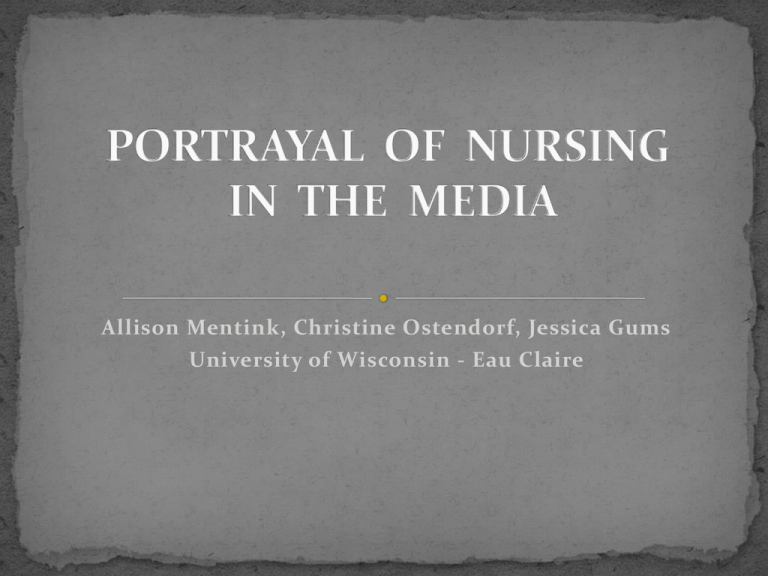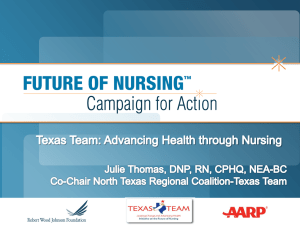
Allison Mentink, Christine Ostendorf, Jessica Gums
University of Wisconsin - Eau Claire
We have all heard stories regarding nurses: killer
nurses, incompetent nurses, poorly trained nurses and
of course the entertainment media have their “naughty
nurses”
Negative/derogatory portrayal of nursing in the media
has become more prevalent over the past 50 years. This
has heightened with more negative images in the past
20 years.
The medias portrayal of nurses is one of the most
difficult to compete with
Print ads
Radio
News coverage
Books
Internet
Television
Movies
2008 Gallup poll ranked nurses #1 for honesty and
ethics
Trust is not the same as respect!
Nursing is an autonomous profession
TV, movies, and news accounts frequently give credit
for the work nurses do to physicians or hospitals
People are affected by what they see and hear – this is
why companies and politicians spend millions of
dollars on advertising
Entertainment education
In the 1950s and 1960s, the American Medical
Association asserted control over network television
shows, ensuring scripts included heroic physicians
Where are all the nurses?
In 2008, 39 of 43 major characters on the top 5 U.S. health
related prime time TV shows were physicians. In reality, there
were 3 million nurses and 700,000 physicians; a 4:1 ratio
WHAT REAL NURSE DO
WHAT TV NURSES DO
Educate
Answer Phones
Patient Advocate
Follow Doctor Orders
Triage
Have Affairs with Doctors
Monitor Patients
Assist Doctors
Provide Emotional Support
Watch Doctors Save Lives
Perform Procedures
Save Lives
2000 survey by the U.S. Centers for Disease Control
and Prevention showed:
52% of people reported getting information they trust to
be accurate from a prime time TV show
Greater than 25% said such shows are among their top 3
sources for health information
9 out of 10 regular viewers said they learned something
about diseases from TV
Almost 50% took some action after watching the show
42% told someone the storyline
16% told someone to do something or did something
themselves
9% visited a clinic or physician
From 2003-2005,
NBC’s daytime
soap opera
Passion’s had an
orangutan play
the role of
Precious – a
private duty
nurse.
Angels of Mercy until end of WWII
1920’s to end of WWII – pragmatic, even heroic
A Farewell to Arms (1932)
1930’s-1940’s – Dr. Kildare films introduced nurses as
love interests
1940’s-1960’s – series of juvenile novels about Cherry
Ames
Adventurous, bright, young nurse crime solver
1950’s-1960’s – AMA asserted control over network
television
Heroic physician characters virtuous,
no mistakes
1960’s brought the naughty nurse, balanced by the
senior battle-ax
Quality of nursing portrayal decreased in both film
and prime time television
One Flew Over the Cuckoo’s Nest (1975)
1962-1965: The Nurses series
1960’s and 1970’s: increase in portrayal of explicit
sexual activity
Catch 22 (1970)
M.A.S.H. (1972)
Kalischs of University of Michigan Nursing School
published multiple studies in the 1980’s
Nurses were shown as peripheral assistants to
dominant physicians
St. Elsewhere 1982-88 showed occasional formidable
nurse character
China Beach 1988-91 lead character colleen McMurphy
was competent, tough army nurse but did not
generally display much skill
TV sitcom Nurses 1991-94 treated nurses with some respect
Nightingales 1988-89 featured sexy nursing students who
spent so much time partially undressed that outraged
nurses actually managed to chase the show off the air
ER 1994 One of the most influential health care shows in
history. Fairly realistic scenes, some of the best depictions
of nursing ever to appear on network TV, occasionally
showed serious nursing skill and autonomy, but as a whole
depicted nurses as the handmaiden, as a skilled physician
assistant who must defer to him.
2000-2006 Strong Medicine on Lifetime had a handsome,
articulate nurse midwife Peter Riggs, but other nurses were mute
handmaidens
2001-Present Scrubs, main nurse Carla Espinosa at times shows
real skill, but also shows doctors starting iv’s and hanging
medications and providing virtually all care
House stated nurses were invented to pick patients up when they
fall and to get him coffee
Private Practice only has one nurse/receptionist character-male
midwife student
HawthoRNe – Told from the point of view of nurses as they
struggle against the odds to deliver the best care possible.
Several different nurses in different stages of their nursing careers.
Nurse Jackie – Portrays an irresponsible nurse that is
addicted to pain medications and does things the way
she wants to, not the legal way.
Nursing shortage
Prevented men from entering nursing
Reduced respect and trust in nursing
Reduced the patient population of nurse practitioners
Nurses must recognize that they have the power to
change the profession
Project a professional image
Write letters to editors and producers
Hospital managers can promote nursing just like they
do medicine
Media can consult with nurses
Hollywood can include characters to reflect real
nursing work
“Most people know they can’t get into a hospital
without a doctor. What they don’t know is that they
won’t get out of one – at least not alive – without a
nurse.”
- Nursing Historian Joan Lynaugh
Adler, J. (2009, February 28). The nurse will see you now. Newsweek. Retrieved
from http://www.newsweek.com/2009/02/27/the-nurse-will-see-younow.html
Buresh,B. & Gordon,S. (2006). From silence to voice: What nurses know and must
communicate to the public (2nd ed.). Ithaca, NY: Cornell University Press.
Fealy, G. M. (2004). The good nurse: Visions and values in images of the nurse.
Journal of Advanced Nursing, 46 (6), 649-656.
Gordon, S. (2005). Nursing against the odds: How health care cost cutting, media
stereotypes, and medical hubris undermine nurses and patient care. Ithaca,
NY: Cornell University Press.
Kalisch, B.J. & Kalilsch, P. A. (1983). Improving the image of nursing. The
American Journal of Nursing, 83 (1), 48-52.
Kalisch, B.J., Kalisch, P.A. & McHugh, M.L. (1982). The nurse as a sex object in
motion pictures, 1930 to 1980. Research in Nursing and Health, 5, 147-154.
Kalisch, P. A., Kalisch, B.J. & Clinton, J. (1982). The world of nursing on prime
time television, 1950 to 1980. Nursing Research, 31 (6), 358-363.
Lusk, B. (2000). Pretty and powerless: Nurses in advertisements, 1930-1950.
Research in Nursing & Health, 23 (3), 229-236.
Saad, L. (2008). [Graph illustration Top rated professions for honesty and ethics
Nov 7-9, 2008] Nurses shine while bankers slump in ethics rating. Retrieved
November 10, 2010, from Gallup: http://www.gallup.com/poll/112264/NursesShine-While-Bankers-Slump-Ethics-Ratings.aspx
Schorr, T. (1963). Nursing's TV image. American Journal of Nursing, 63 (10), 119-121.
Spangler, R. W. (1955). We're on TV every week. American Journal of Nursing, 55
(5), 592-593.
Summers, S., & Summers, H. J. (2009). Saving lives: Why the media's portrayal of
nurses puts us all at risk. New York, NY: Kaplan Publishing.
Takase, M., Maude, P., & Manias, E. (2006). Impact of the perceived public image
of nursing on nurses' work behaviour. Journal of Advanced Nursing, 53 (3), 333343.









